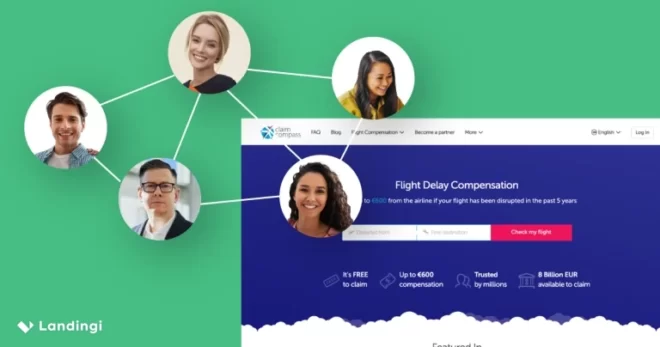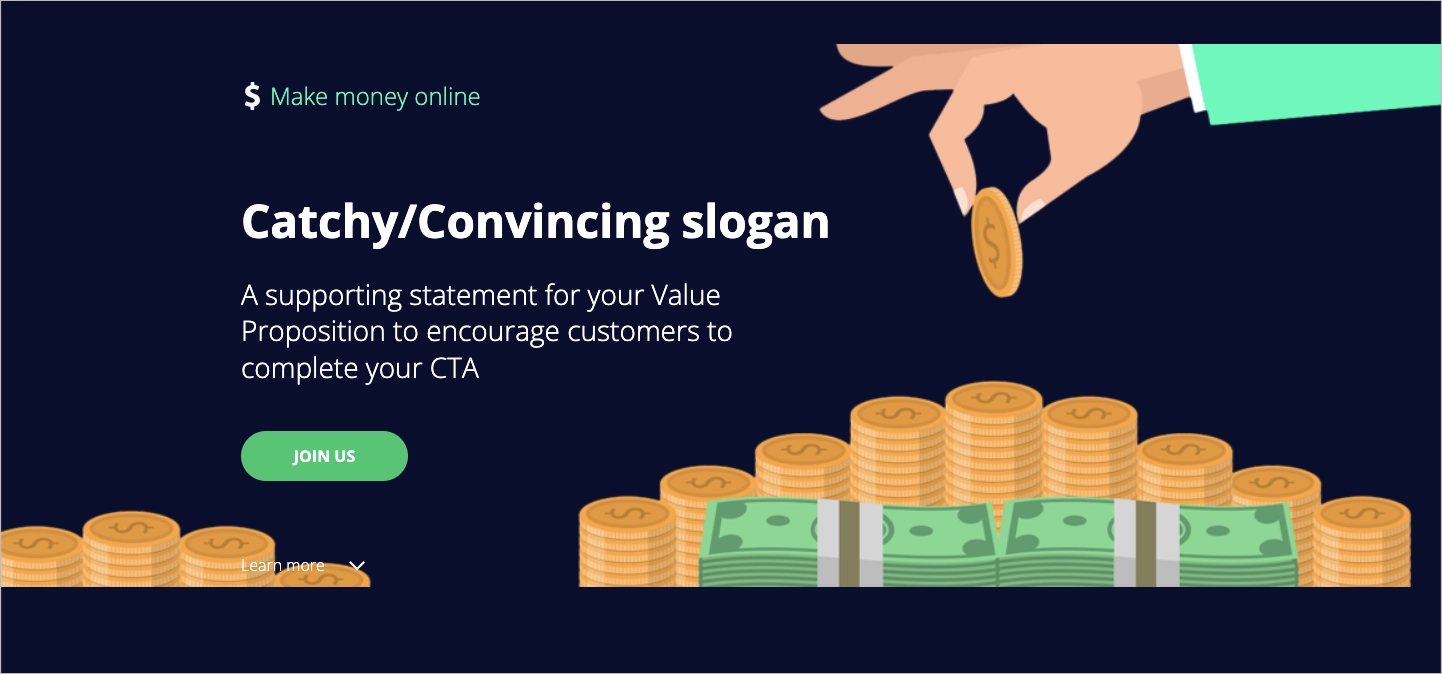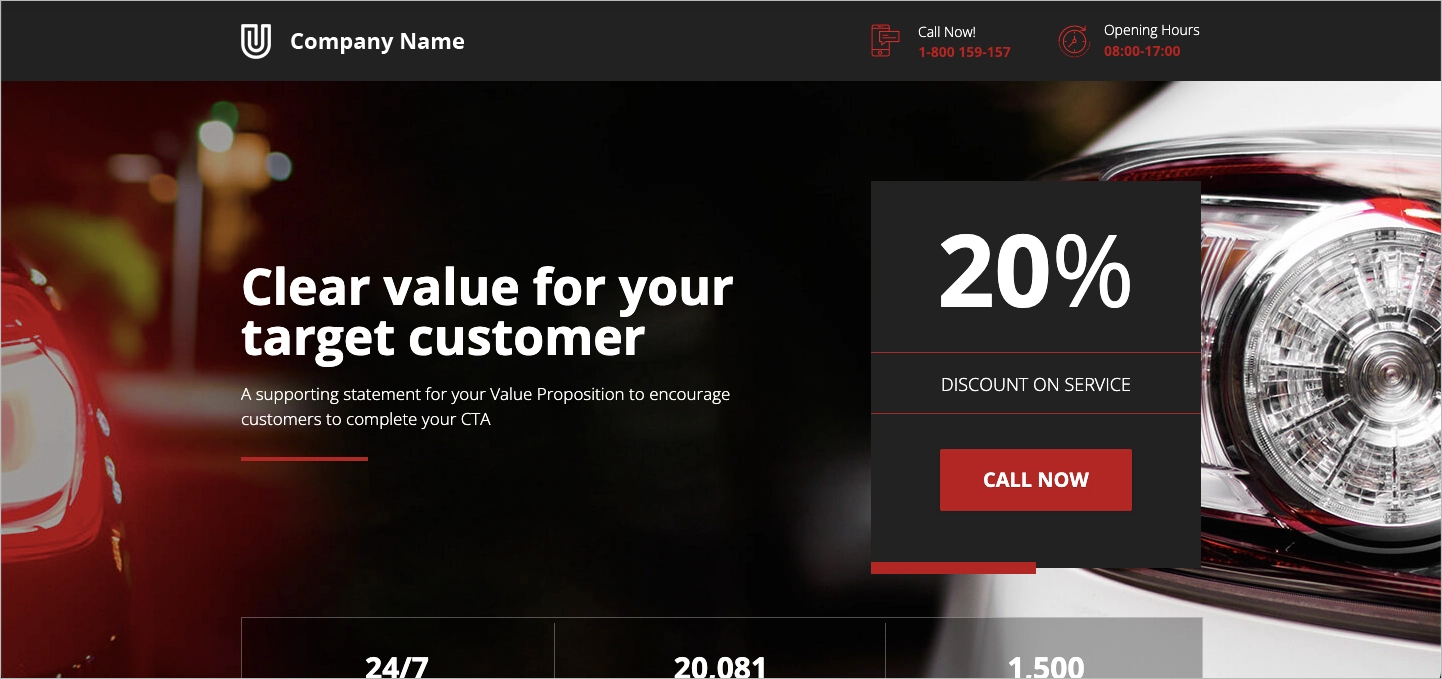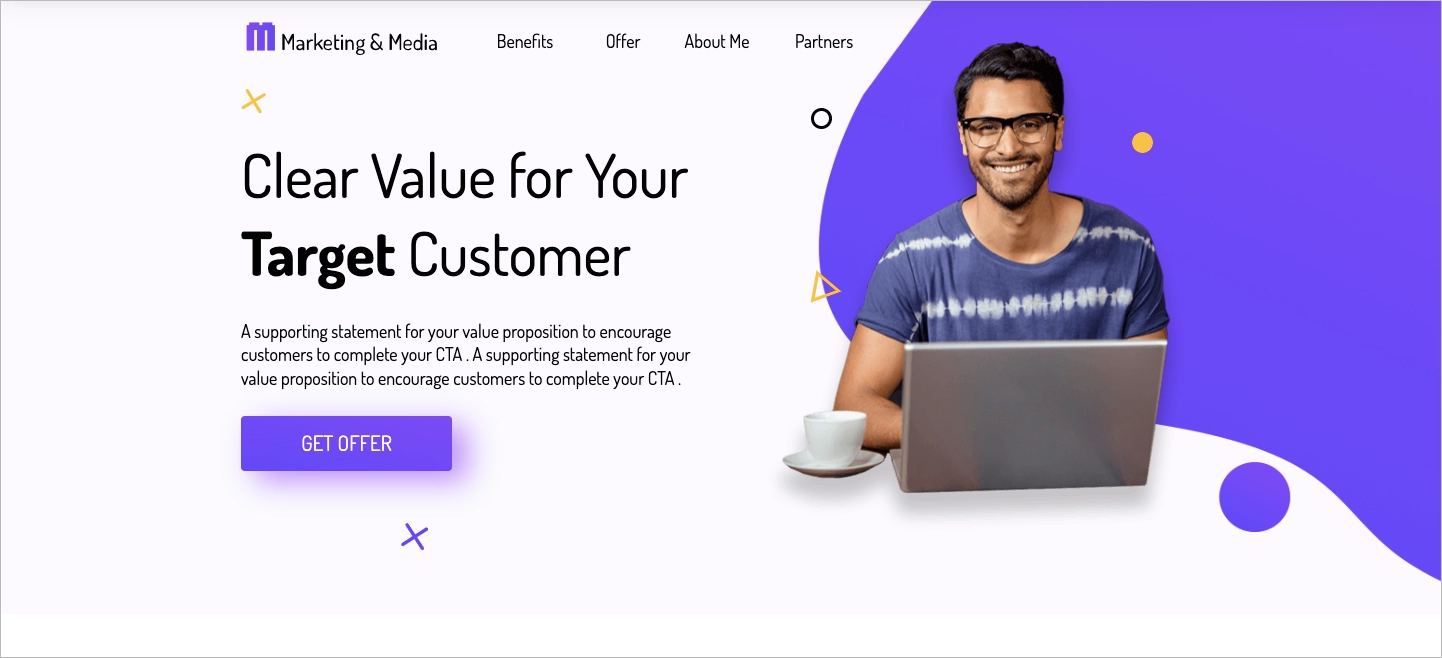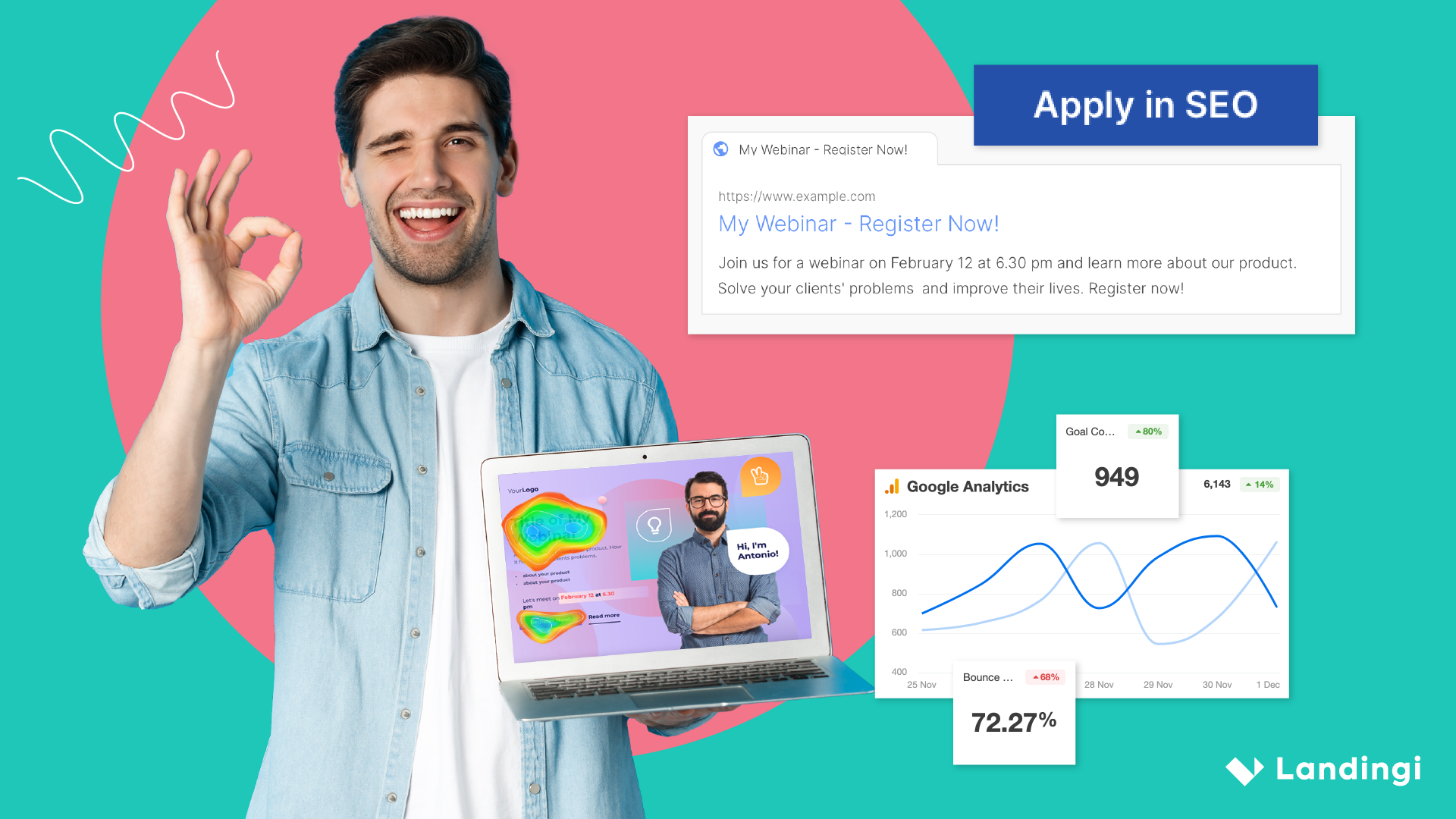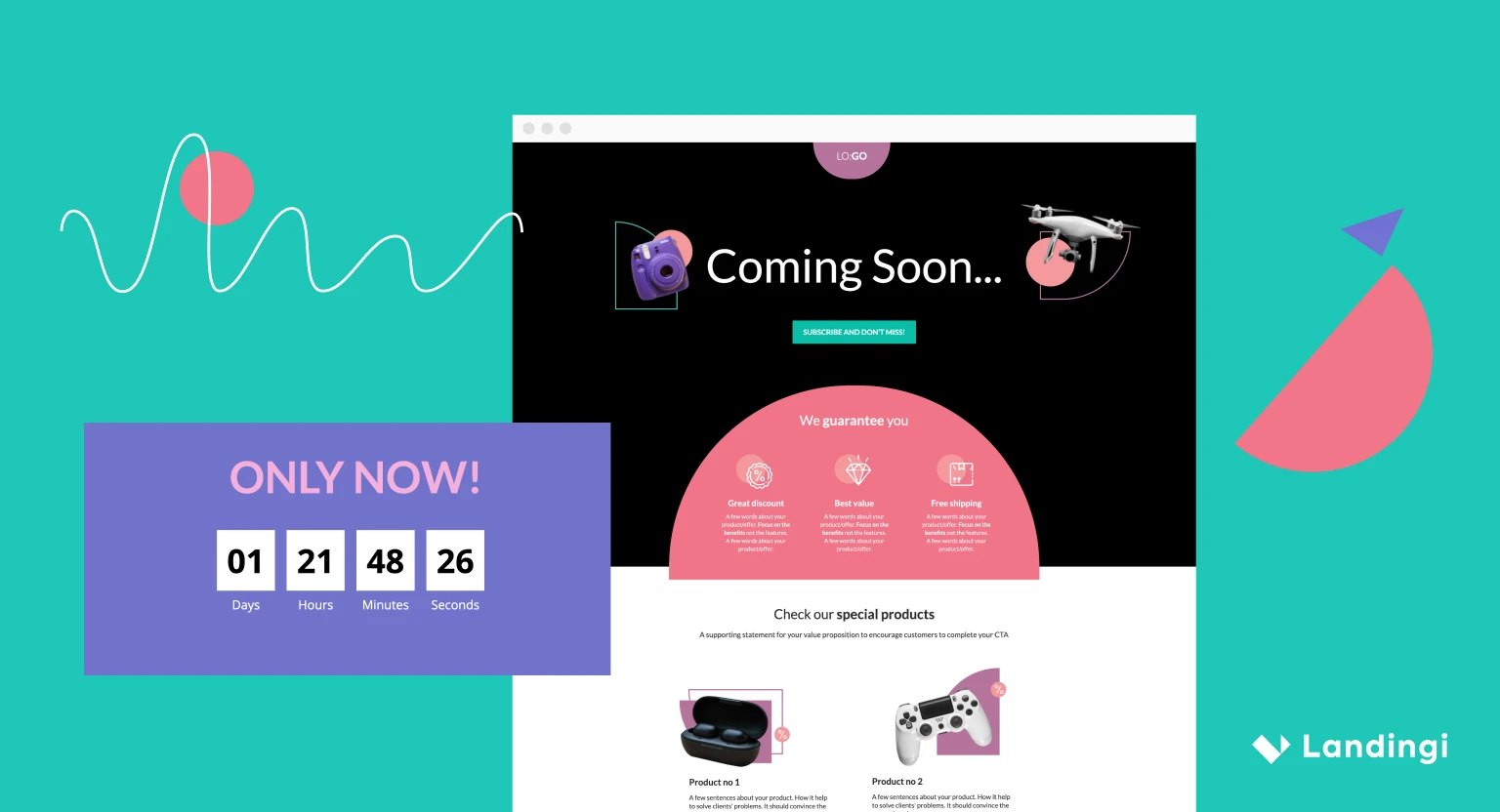One affiliate landing page can make or break an entire marketing campaign. A well-optimized page can attract numerous qualified prospects who can become long-term partners. In this article, we will explore everything you need to know about landing pages for affiliate marketing, from their definition to tips on creating successful ones. It’s important to ensure these pages are clear, engaging, and persuasive to convert visitors effectively.
Take a look at the list below to immediately access tips for creating affiliate landing pages:
- Simplify the message and focus on one offer.
- Use high-quality visuals to support your message.
- Highlight benefits, not features.
- Create urgency with limited-time offers.
- Optimize for SEO with relevant keywords and unique meta descriptions.
- Ensure design and message consistency across materials.
- Include multiple CTAs throughout the page.
- Remove distractions and external links.
- Use persuasive writing and storytelling.
- Continuously test and adjust based on performance data.
- Improve page load speed by optimizing images and code.
- Use visual cues to direct attention to CTAs.
In today’s article, we will also provide real-world examples to help you create effective affiliate landing pages. Here are the 16 examples we will analyze:
- Kwik.insure
- ClaimCompass
- Animaker
- Shopify
- Landingi
- BigCommerce
- Wati
- Coursera
- Jimdo
- Time etc
- Miro
- Involve Your Senses
- iCard
- DesignNBuy
- MACMAN Pro
- Discover Cars
What is Affiliate Marketing?
Affiliate marketing is a strategy in which a seller, called an affiliate seller, earns a commission for marketing and selling another company’s products. This can be a great deal for owners, affiliates, and customers when the process runs smoothly. But it also means it’s important your affiliates have effective marketing tools.
Affiliate marketing (sometimes called referral marketing) continues to grow each year. According to SaaS Scout, U.S. advertisers generate between 15-30% of their total sales from affiliates. It’s caught up with email marketing, paid search, and social media marketing, making it one of the most effective digital advertising techniques.
In a landscape with so much competition, it’s crucial to excite both affiliates and customers to make sure you bring in the most business you can. If you’re incorporating landing pages into your affiliate marketing strategy, your landing page for potential affiliate partners has to rise above the rest and speak for itself to drive successful traffic.
What is Affiliate Landing Page?
An affiliate landing page is designed to optimize your affiliate marketing campaign, aiming to attract as many potential affiliate partners to your offer as possible to enhance conversions. A landing page designed for conversions is essential in driving the desired actions from visitors. Standing out as a distinct page, its primary goal mirrors that of any landing page: to funnel site visitors towards a single offer, highlighted by an engaging call-to-action.
Unlike generic landing pages, which target a more uniform source of traffic or marketing channel, affiliate landing pages find their strength in diversity. They are tailored to capture attention from multiple online sources – be it organic search, paid ads, email newsletters, or social media – ensuring the message and brand remain consistent across different platforms.
Optimizing a landing page for affiliate marketing requires a strategic approach to cater to a broad spectrum of traffic sources without losing the core message or diluting the brand’s impact. An affiliate’s landing page is specifically designed to drive conversions, which leads to commissions, making the process highly rewarding for both affiliates and the primary brand.
How to Create a Landing Page for Affiliate Marketing?
To create a landing page for affiliate marketing, focus on crafting a compelling headline with appealing visuals and concise copy to engage visitors, along with clear CTAs and relevant social proof to boost conversions. Understanding your audience’s needs and benefits is crucial for optimizing your page to increase affiliate traffic effectively.
To create a landing page for referral marketing, it is essential to include the following elements for the best outcomes:
Compelling Headline & Hook
The headline needs to capture the reader’s attention and make them want to learn more. Encourage them to keep reading or scrolling so you can draw them toward your CTA. Your headline is what will keep visitors from clicking out of your landing page right away.
Appealing Visuals & Simple Design
Visuals can give your affiliate landing page a major boost. According to Matthew Dunn from Email Audience, images are processed between 6 and 600 times faster than text. That’s certainly something you can tap into for increased engagement.
The visuals you need might vary depending on the landing page or campaign. Trust your design skills, or try out one of our templates to get started. Aim for a design that is both appealing and clean, without distractions. You still want to direct your viewer’s attention to your CTA.
Clear, Concise Copy
After you’ve put together your headline and images, you don’t want to lose your visitor on the copy. Your copy really only needs to do two things: resonate with your audience, and pull them toward your CTA with clear, simple language. You want to show your audience you have a solution to their problem.
If your copy is too short, you might not convey your benefits and offer effectively. If your copy is too long (or boring), you risk losing your audience’s attention before they reach the CTA. Experiment with your content and length for each offer to find that sweet spot.
Relevant Social Proof
We tend to have a very high perceived value of social proof from sources we trust. This can include testimonials, reviews, or endorsements, and these can carry heavy weight in affiliate markets where the audience is looking for recommendations from people they trust.
Similarly, customers rarely rely on a single opinion to make a purchase, so providing an array of social proof could work in your favor. Keep your audience engaged by presenting them with all the social information they need to make their purchasing decisions, if possible.
A Direct Call-to-Action (CTA)
Your reader finally arrives at the CTA. This is the big moment where you hope that your visitor will go through with that click, that sign-up, that share.
No matter the offer or the specific goal, make sure your CTA is clear. Show readers what they need to do to take the next step, make it as easy as possible for them, and don’t leave any space for doubt. It can be a good idea to experiment through A/B testing to fine-tune the details of your CTA and maximize conversions. You can also analyze invaluable data on micro-conversions, which provides you with in-depth insight into users’ behavior and allows you to identify their obstacles throughout the their journeys.
Know Your Benefits, Make Them Clear
At the end of the day, to create a successful affiliate landing page, this is the information you need to know cold. You should be familiar with your audience — what they like, their interests, their demographics — and you should know how to communicate to them just what they’ll get out of your offer.
The better you know your market, the better you can optimize your landing page, even if you’re targeting a specific range of affiliate traffic.
16 Best Examples of Affiliate Landing Pages
Looking at the best affiliate landing page examples can provide inspiration and insights into what works. Effective affiliate marketing pages, such as those from Miro and Shopify, demonstrate the importance of clear messaging, compelling visuals, and straightforward CTAs.
1. Kwik.insure
The Kwik.insure affiliate landing page exemplifies an efficient affiliate marketing strategy, designed to attract and convert potential affiliates. The page prominently features a banner image that visually aligns with the brand’s aesthetic, making a strong initial impression. The primary sections are laid out to guide visitors through the process of joining the affiliate program, starting with clear instructions on how to sign up, promote, and earn through referrals. This step-by-step guide, accompanied by relevant icons, ensures that potential affiliates understand the program’s mechanics and benefits.
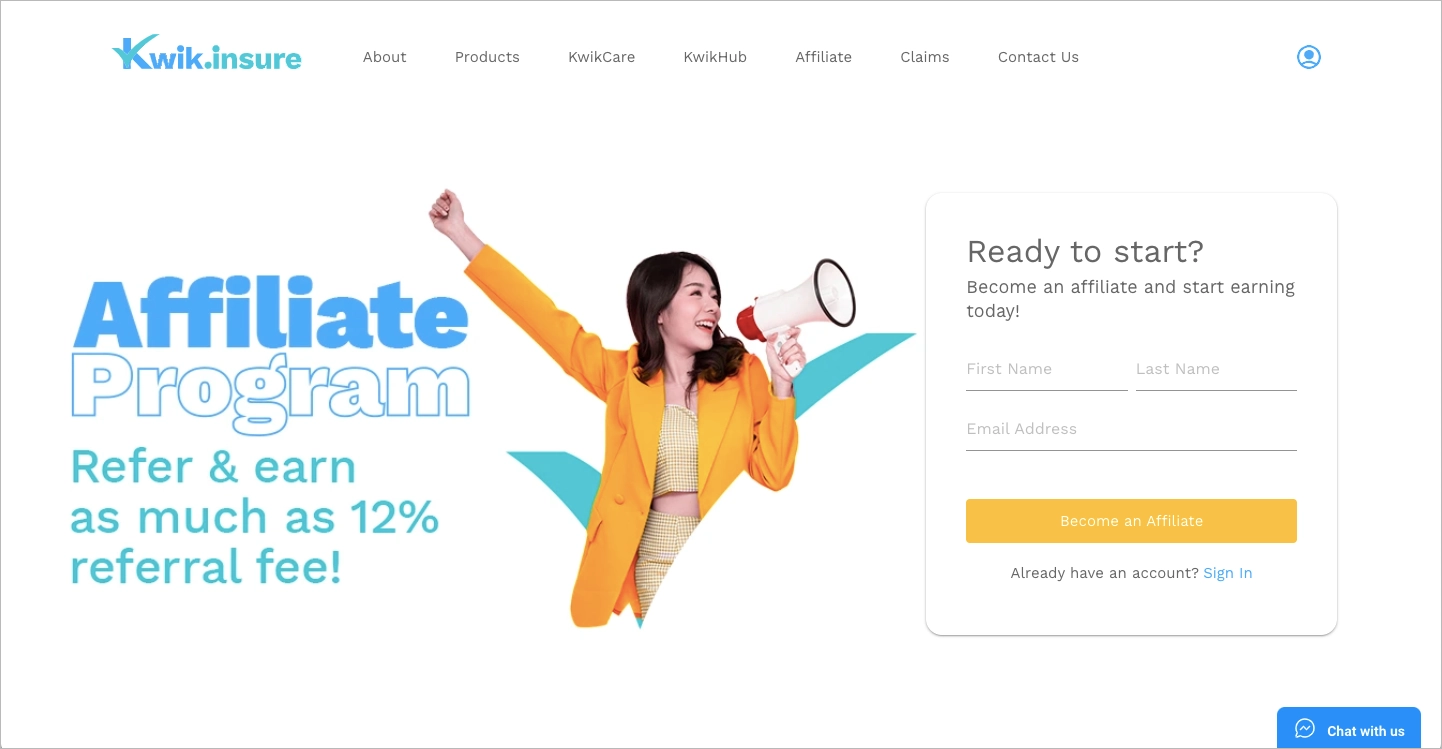
The page also includes detailed information about the affiliate program mechanics, explaining the registration process, referral methods, and payout details. Video testimonials from current affiliates add a layer of social proof, enhancing the credibility of the program. The “Ready to start?” section provides a straightforward call-to-action, encouraging visitors to sign up immediately. The footer reiterates essential legal information, maintaining transparency and trust.
Key takeaways to learn from this example:
- Step-by-step guide: Clear instructions help visitors understand the process better.
- Images and icons: Compelling visuals enhance user engagement and understanding.
- Video testimonials: These interactive elements serve multiple purposes: they engage, provide social proof, and increase credibility.
Improvement areas:
- Content proportions: The description of the Affiliate program mechanics is a lengthy and tedious block of text. While videos are highly engaging, stacking them one after the other reduces their appeal.
2. ClaimCompass
The ClaimCompass landing page serves as an effective example of an affiliate landing page. The page is structured to engage visitors by offering them the opportunity to earn money by helping fellow passengers get compensated when their flights are delayed or canceled. The headline is clear and immediately communicates the primary value proposition. The page features visually appealing images, a cohesive color scheme, and prominent CTA buttons that guide the user towards signing up for the affiliate program.
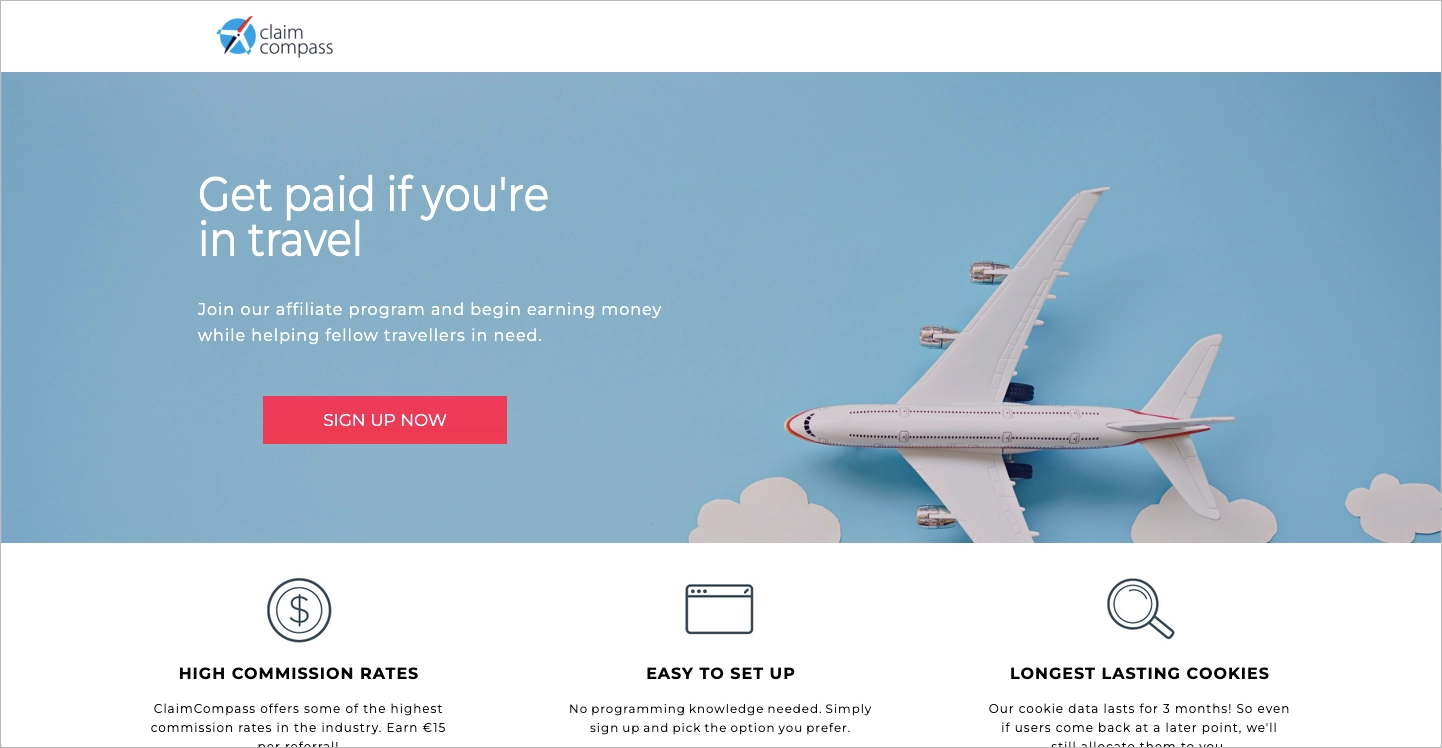
The layout is user-friendly, ensuring easy navigation and a seamless user experience. Key information is presented concisely, and the design is responsive, making it accessible on both desktop and mobile devices. The use of high-quality images and consistent branding elements helps to establish trust and credibility with potential affiliates.
Key takeaways from this example:
- Clear value proposition: The headline and descriptions clearly communicate the benefits of the affiliate program.
- Prominent CTAs: Strategically placed buttons encourage user engagement and conversions.
- Visual appeal: High-quality images and a cohesive color scheme enhance the user experience.
- Responsive design: The page is accessible and functional on various devices, ensuring a broad reach.
Improvement areas:
- Font size: A bigger font size would increase accessibility.
3. Animaker
The Animaker affiliate landing page effectively promotes its affiliate and enterprise lead generation programs. The page features a clear and engaging headline, “Become an Animaker affiliate partner or enterprise lead gen partner,” and a prominent call-to-action button, “Become Affiliate Partner,” which encourages visitors to sign up immediately. The design is clean and professional, with a layout that highlights the benefits of joining the program and makes the sign-up process straightforward.
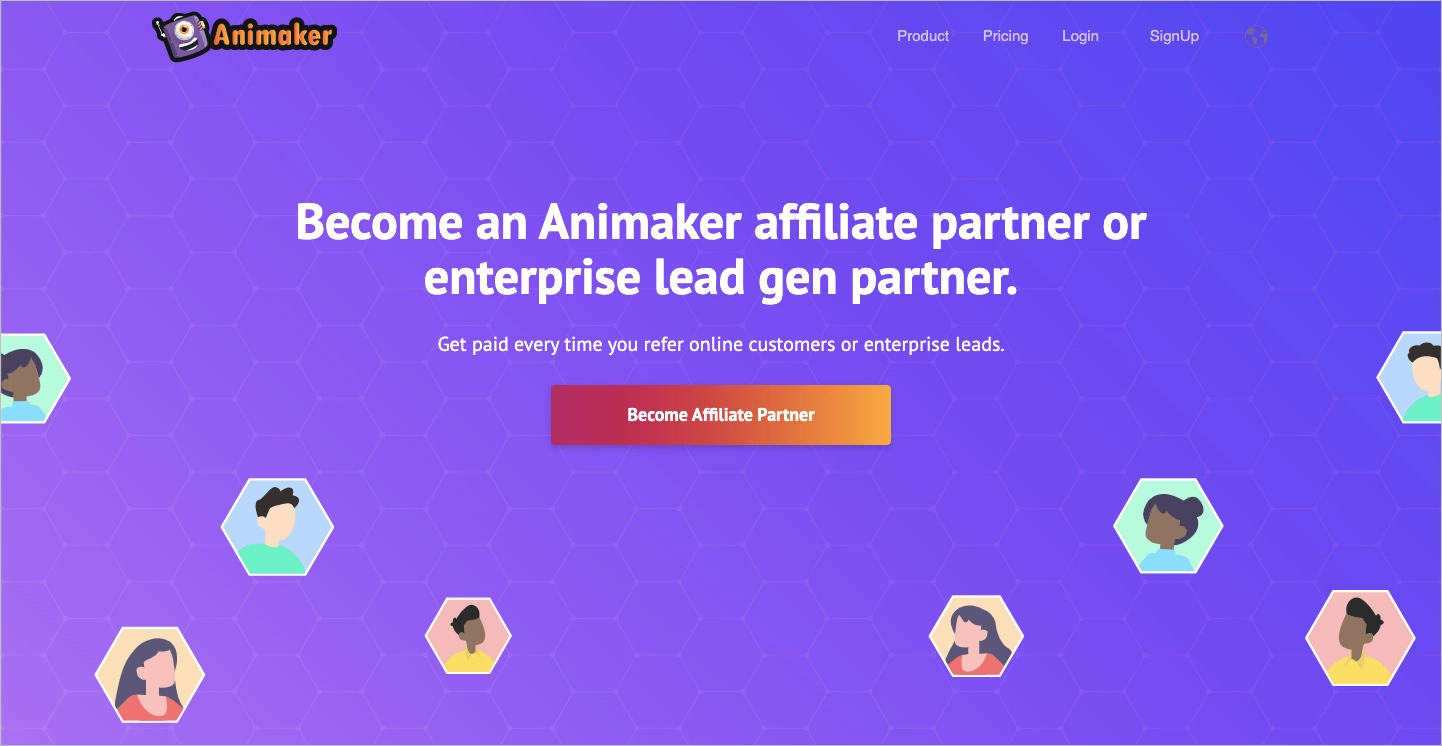
The page also emphasizes the advantages of partnering with Animaker, such as earning uncapped commissions and access to a dedicated partner management team. Additionally, it outlines the various types of content creators who can benefit from the program, from bloggers and social media influencers to agencies and enterprise-level businesses. This approach ensures that the page appeals to a broad audience, increasing the likelihood of attracting diverse partners.
Key takeaways to learn from this example:
- Clear and engaging headline: Hero section immediately communicates the partnership opportunity.
- Prominent CTAs: Buttons encourage immediate action to sign up as an affiliate partner.
- Highlighting benefits: They outline the advantages of joining the program, such as uncapped commissions and dedicated support.
- Broad audience appeal: The landing page targets different types of content creators, from bloggers to enterprise businesses.
Improvement areas:
- User interactivity: Adding interactive elements, such as testimonials or success stories from existing affiliates, could enhance engagement and build trust.
- Secondary CTA: The secondary call-to-action appears identical to the first CTA, potentially causing confusion for visitors.
4. Shopify
The Shopify Affiliate Marketing Program landing page is an exemplary model of an effective affiliate landing page. The page is designed to attract and engage potential affiliates by offering a clear value proposition. The header section prominently features a call-to-action button labeled “Apply now,” inviting users to join the affiliate program and start earning commissions. The headline “Become a Shopify Affiliate” and the subheading “Earn commission when you refer new merchants to select Shopify plans or Shopify Point of Sale (POS Pro)” succinctly communicate the purpose and benefits of the program.
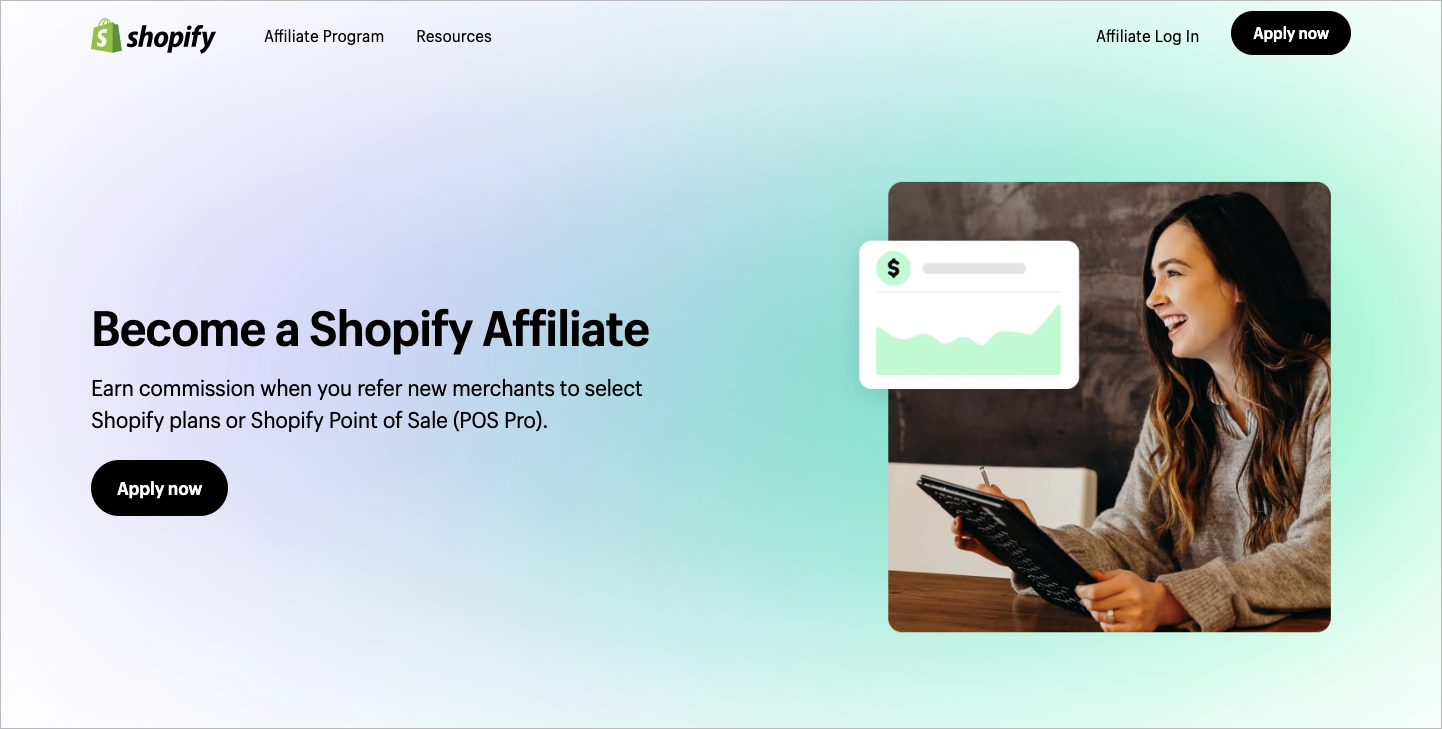
The page layout is clean and user-friendly, featuring a visually appealing design with strategic use of whitespace, high-quality images, and a cohesive color scheme that aligns with Shopify’s branding. The sections are well-organized, guiding visitors through the benefits and steps of becoming an affiliate. The “Two ways to refer and earn” section clearly outlines the earning opportunities through Shopify Plan referrals and Shopify POS Pro referrals, each with a corresponding image and descriptive text. This approach helps potential affiliates quickly understand how they can earn commissions.
Key takeaways to learn from this example:
- Clear value proposition: The page clearly communicates the benefits of joining the affiliate program.
- Strong CTA buttons: Prominently placed “Apply now” buttons encourage immediate action.
- Visually appealing design: High-quality images and a cohesive color scheme enhance engagement.
- Organized content: The information is presented in a logical, easy-to-follow manner.
- Trust-building elements: Testimonials and success stories from existing affiliates build credibility.
Improvement areas:
- Mobile optimization: Ensuring the page is fully optimized for mobile devices can improve the user experience for mobile visitors and potentially increase conversion rates from this audience.
5. Landingi
The Landingi affiliate program landing page is a well-designed example that effectively communicates the benefits of joining the affiliate program. The page features a clear and concise headline that immediately grabs the visitor’s attention: “Join Our Affiliate Program – Earn Commissions.” The primary focus is on encouraging sign-ups by highlighting competitive commissions, easy sign-up processes, and robust support and tracking features. The layout is clean and professional, with strategically placed call-to-action buttons that guide the user towards registration.

The design uses a consistent color scheme that aligns with the Landingi brand, providing a visually cohesive experience. The use of high-quality images and icons throughout the page adds visual interest and breaks up the text, making the content more engaging and easier to digest. The page also features an FAQ section and social proof in the form of testimonials from existing affiliates, which helps to build trust and credibility.
Key takeaways to learn from this example:
- Clear, impactful headline: The copy captures attention and immediately conveys the page’s purpose.
- Strong CTAs: Prominently placed and easy to follow, leading to higher conversion rates.
- Professional, cohesive design: The page uses a consistent color scheme and high-quality images to create a visually appealing page.
- Social proof: Testimonials build trust and credibility.
Improvement areas:
- Enhancing interactivity: Adding interactive elements, such as a live chat option could engage users more effectively.
6. BigCommerce
The landing page for BigCommerce’s affiliate program is a great example of an effective affiliate landing page. The page is designed to attract potential affiliates by clearly outlining the benefits of joining the program. The headline “Earn money with the BigCommerce Affiliate Program” immediately conveys the primary value proposition, enticing visitors to learn more about the opportunity.
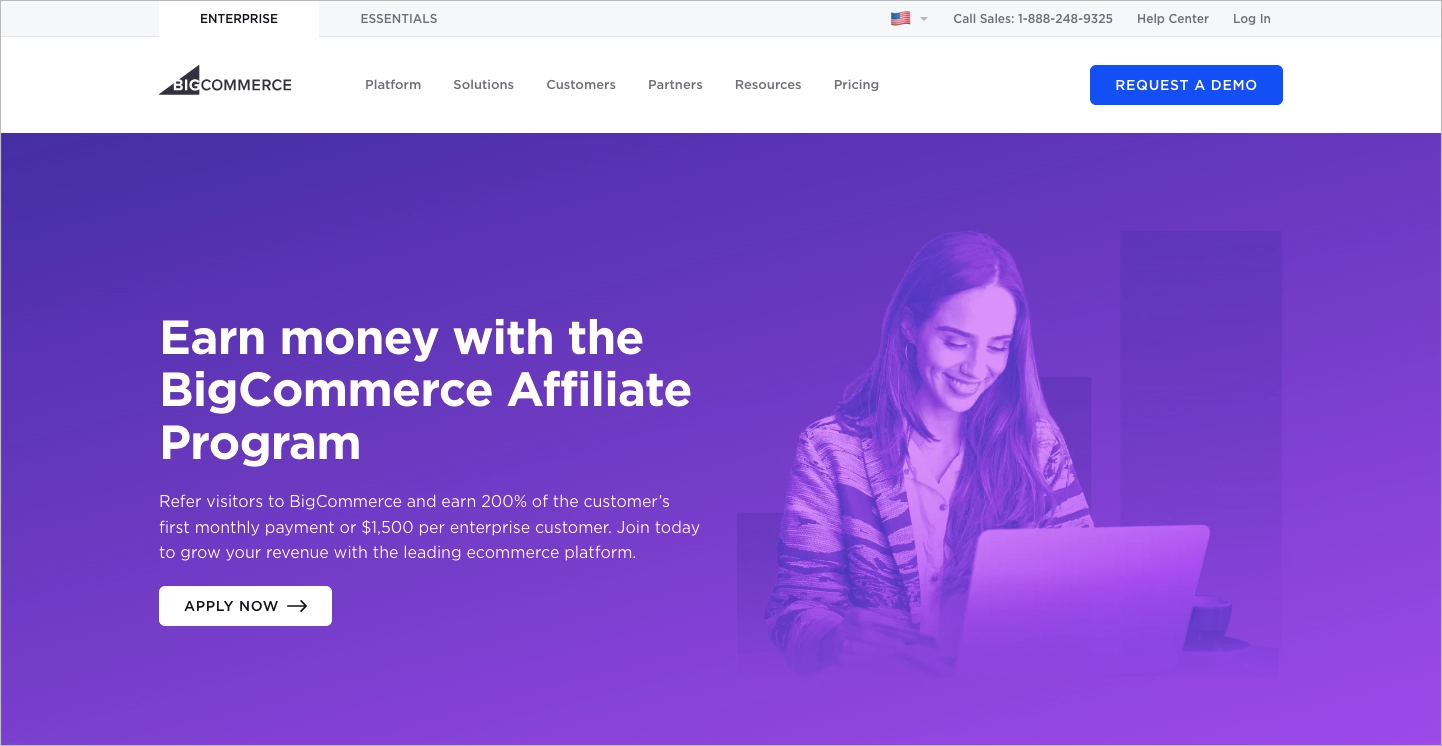
The page employs a clean and professional design with a simple layout, making it easy for users to navigate. Key information, such as the high commission rates (200% of the customer’s first monthly payment or $1,500 per enterprise customer), is prominently displayed. The call-to-action (CTA) buttons are strategically placed and visually distinct, encouraging users to sign up or learn more about the program.
Key takeaways to learn from this example:
- Clear and enticing headline: The copy effectively communicates the main benefit.
- Straightforward layout: It ensures ease of navigation and access to key information.
- Prominent CTAs: Buttons encourage immediate action from the visitors.
- High-quality visuals: Images enhance the overall user experience and engagement.
Improvement areas:
- FAQ section: Answering frequently asked questions could enhance engagement and build credibility.
7. Wati
The affiliate landing page of WATI.io effectively promotes their affiliate program with a clear and engaging layout. The headline immediately captures attention, clearly stating the opportunity to partner with Wati and earn a generous recurring commission. The page is well-structured, with a concise introduction to the affiliate program and its benefits, which are highlighted using bullet points for easy readability. The use of a prominent call-to-action (CTA) button, “Become an Affiliate,” ensures that the primary action is unmistakable and easy to follow.
Visually, the page is appealing, with a clean design that uses a consistent color scheme aligned with WATI.io’s branding. High-quality images and graphics enhance the overall presentation, making the content more engaging. The inclusion of testimonials and trust signals, such as company logos of well-known clients, further adds credibility and encourages potential affiliates to sign up.
Key takeaways to learn from this example:
- Attractive hero section: Interactive visuals grab attention and communicate the value proposition.
- User-friendly layout: Sections are well-organized and information is easy to digest.
- Prominent CTA: CTA buttons encourage immediate action.
Improvement areas:
- Simplified form: The form requires completion of six fields, which may overwhelm some visitors.
8. Coursera
The Coursera affiliate landing page provides a compelling example of an effective affiliate marketing platform. The page starts with a clear headline, “Join our Affiliate Program,” and a persuasive subheader, “Transform lives by sharing the world’s best learning experience.” The primary CTA button, “Join for free,” is prominently displayed, encouraging visitors to sign up. The page communicates the value proposition effectively by highlighting the potential to earn up to 45% commission on over 4,000 courses and Specializations.
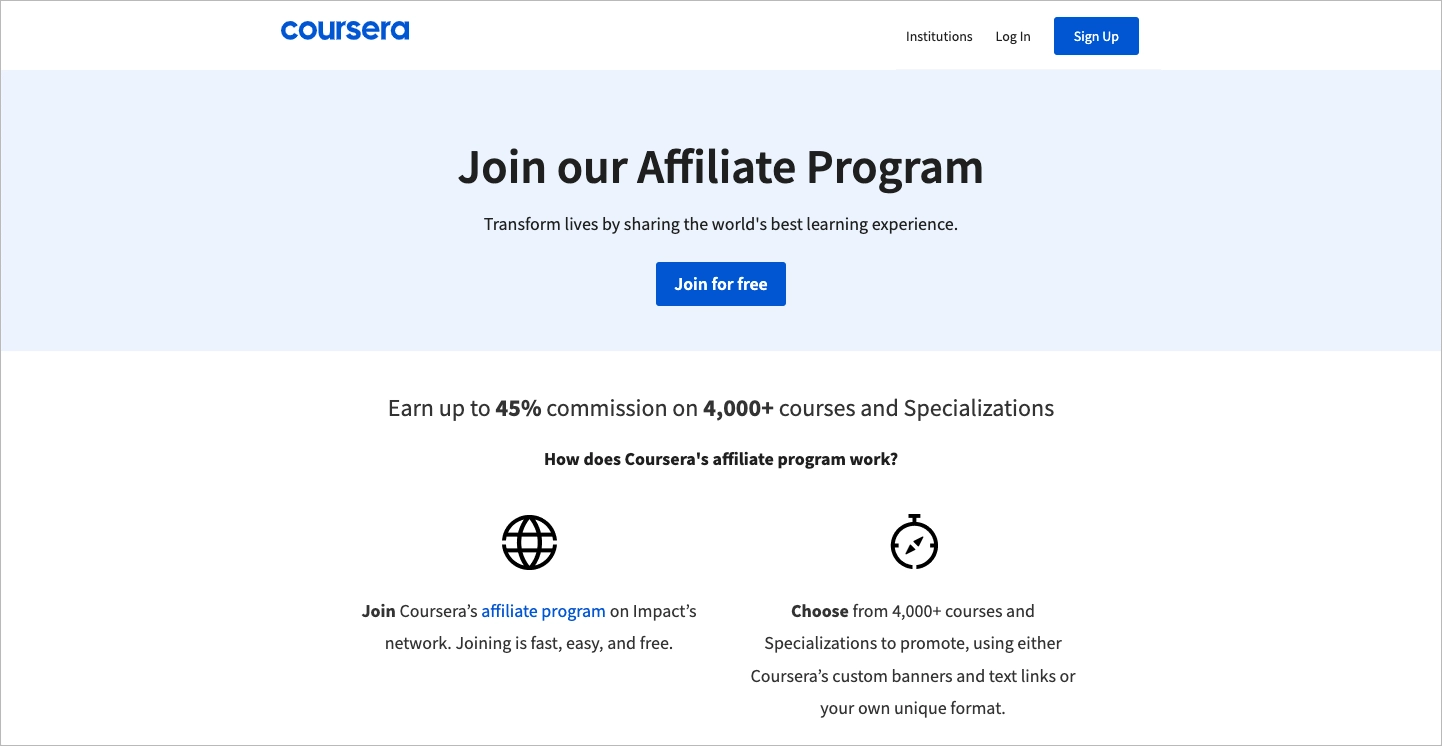
The layout is visually appealing and easy to navigate, with sections that explain how the program works, the benefits of joining, and a comprehensive FAQ section. Each “how” step is accompanied by a relevant image, enhancing understanding and engagement. The benefits section clearly outlines the incentives for affiliates, including baseline commissions, professionally-designed promotional materials, and weekly newsletters.
Key takeaways to learn from this example:
- Clear, engaging headline: The copy attracts attention and sets expectations.
- Prominent CTA button: It encourages immediate action.
- Explanation of the program: Details provide transparency and builds trust.
- Comprehensive FAQ: The page addresses potential questions and concerns.
Improvement areas:
- Visuals: The landing page appears too plain and uninteresting. Adding visuals to the hero section could enhance its appeal.
9. Jimdo
The affiliate landing page for Jimdo is designed to attract new affiliates by offering clear information about the benefits and steps to join the program. The page starts with a clear headline, “Jimdo’s Affiliate Program,” followed by a concise overview of the program’s benefits, such as earning up to 100 euros per customer referred and accessing a range of promotional materials and detailed statistics through the affiliate tool. The call-to-action (CTA) buttons, like “Apply Now,” are prominently placed to encourage immediate engagement.
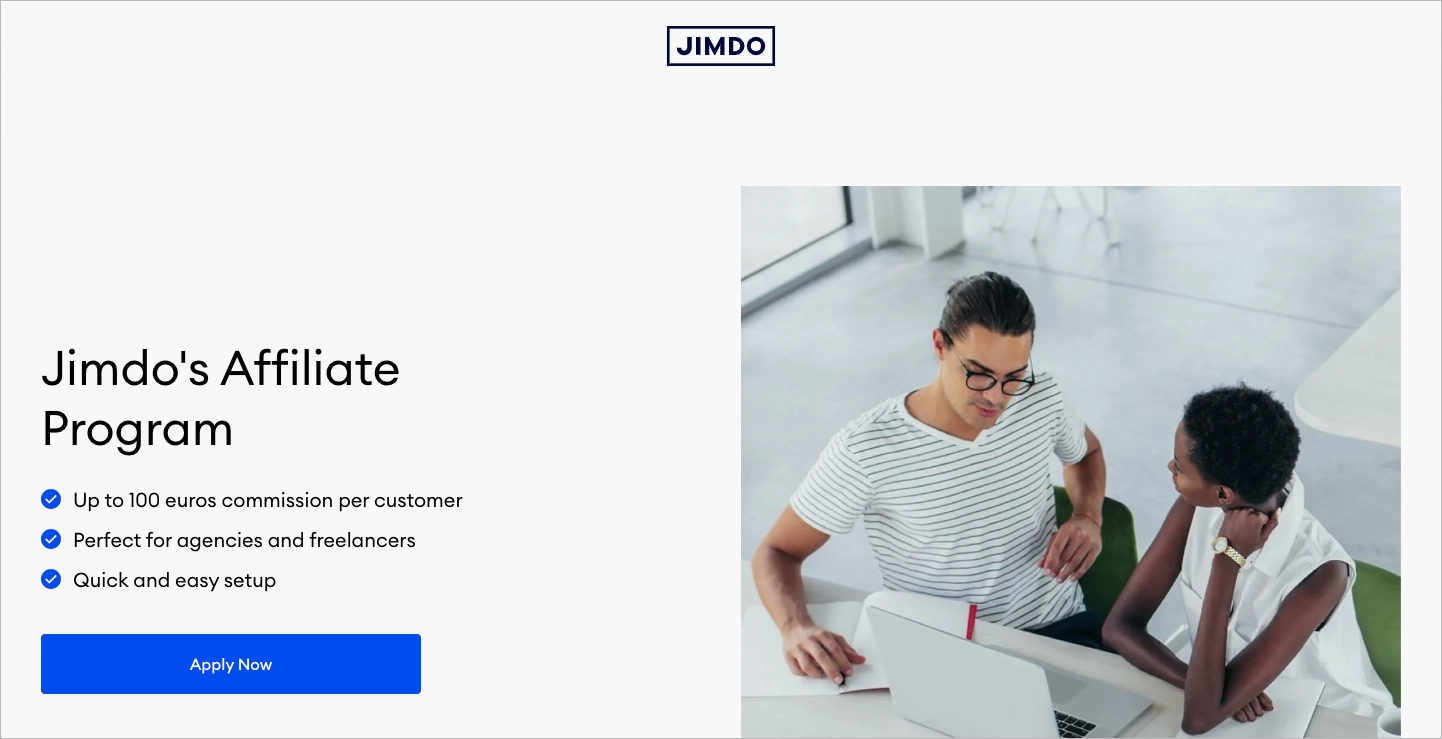
The page’s layout is user-friendly, with a structured three-step process to join the program clearly outlined. This process includes signing up, email verification, and accessing promotional materials. Additionally, an FAQ section addresses common questions about the program, enhancing clarity and reducing potential friction points for prospective affiliates. High-quality images and graphics throughout the page add visual appeal and help convey professionalism.
Key takeaways from this example:
- Clear and concise headline: The program’s purpose is communicated immediately.
- User-friendly layout: The landing page guides visitors through the sign-up process smoothly.
- FAQ section: It addresses common queries to reduce friction.
Improvement areas:
- Social proof: Adding testimonials or other trust signals would increase credibility and improve engagement.
10. Time etc
The affiliate landing page for Time etc is designed to attract and convert potential affiliates into promoting their virtual assistant services. The page has a clean and professional design, with a clear CTA encouraging visitors to join the affiliate program. The main banner features a simple headline, “Join our affiliate program,” and a brief description, “Earn money promoting one of the world’s leading assistant services.” It includes a prominent “Join now” button linked to ShareASale, a well-known affiliate network.
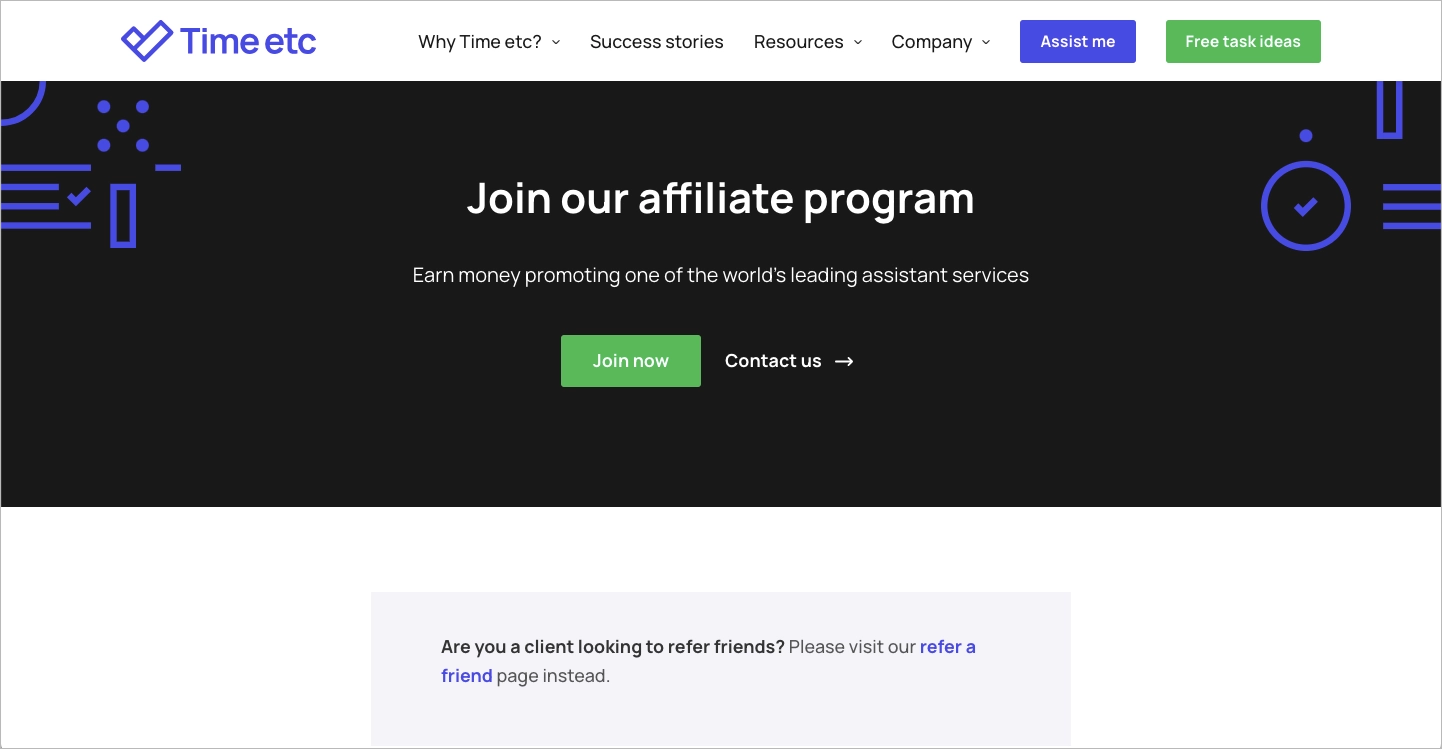
The page outlines the benefits of joining the program, such as earning $250 per sale, free membership, and detailed tracking and reporting features. It provides a simple three-step process to get started: Sign up, Promote and Track, and Earn. This section ensures visitors understand the ease and profitability of the program. Additionally, the footer offers further resources and contact options, enhancing the user experience.
Key takeaways to learn from this example:
- Clear hero section: Simple headline attracts attention immediately.
- Strong CTA: Buttons guide users to take action.
- Highlighting benefits: Program features are clearly listed.
- Simple steps to get started: It’s easy for users to understand the process.
Improvement areas:
- Enhance visual appeal: More engaging images or videos could capture visitor interest.
- Increase testimonials or social proof: Adding more reviews or success stories from current affiliates can build trust and credibility.
11. Miro
The affiliate landing page for Miro’s Affiliate Program is a visually appealing and strategically designed webpage aimed at attracting potential affiliates to join Miro’s program. The page features a modern and clean design with the use of “Roobert PRO” font to maintain consistency and readability. The main headline, “Join Miro’s Affiliate Program,” immediately communicates the core value proposition, and the subheadline, “Do you own a website, blog or YouTube channel? Promote Miro with our affiliate program and earn commissions” further entices visitors with the promise of financial rewards.
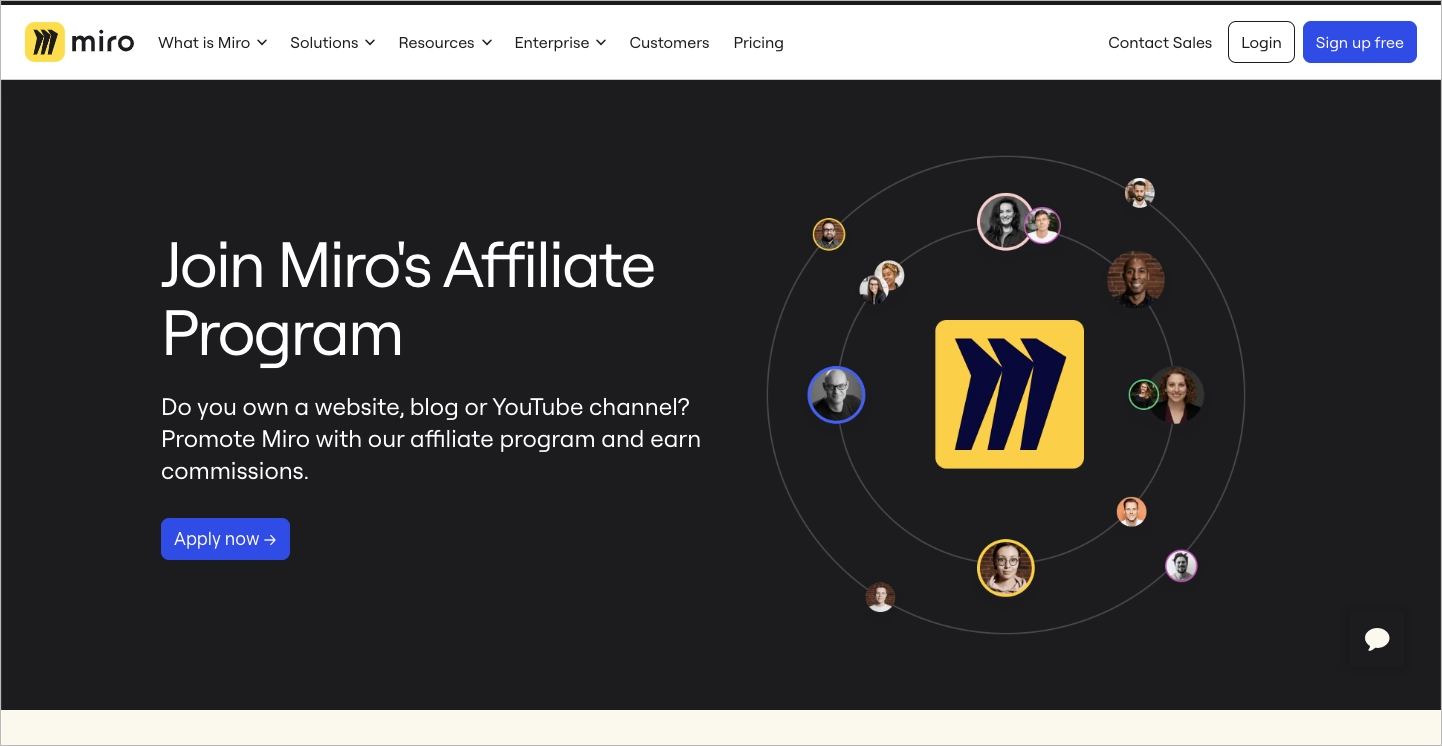
The page structure includes clear and concise sections that guide visitors through the benefits of joining the affiliate program, how it works, and the steps to get started. Modern design and strategic use of empty space enhance the visual appeal and ensure that the call-to-action buttons are prominent and inviting.
Key takeaways to learn from this example:
- Clear value proposition: The copy immediately communicates the financial benefits.
- Clean and modern design: Simplicity ensures readability and visual appeal.
- CTA buttons: Prominent buttons guide visitors towards the desired action.
Improvement areas:
- Interactive elements: Videos or interactive infographics would engage visitors further.
- Social proof: Adding testimonials or logos of partners could build credibility and trust.
12. Involve Your Senses
The “Become Affiliate Partner” landing page by “Involve Your Senses” is a strong example of an affiliate landing page, effectively designed to attract potential partners. The page features a clean and professional layout with a clear call-to-action, inviting users to join the affiliate program and turn their passion into profit. The headline and subheadings are direct and engaging, outlining the benefits and opportunities associated with becoming an affiliate partner. The content is concise and emphasizes the ease of signing up.
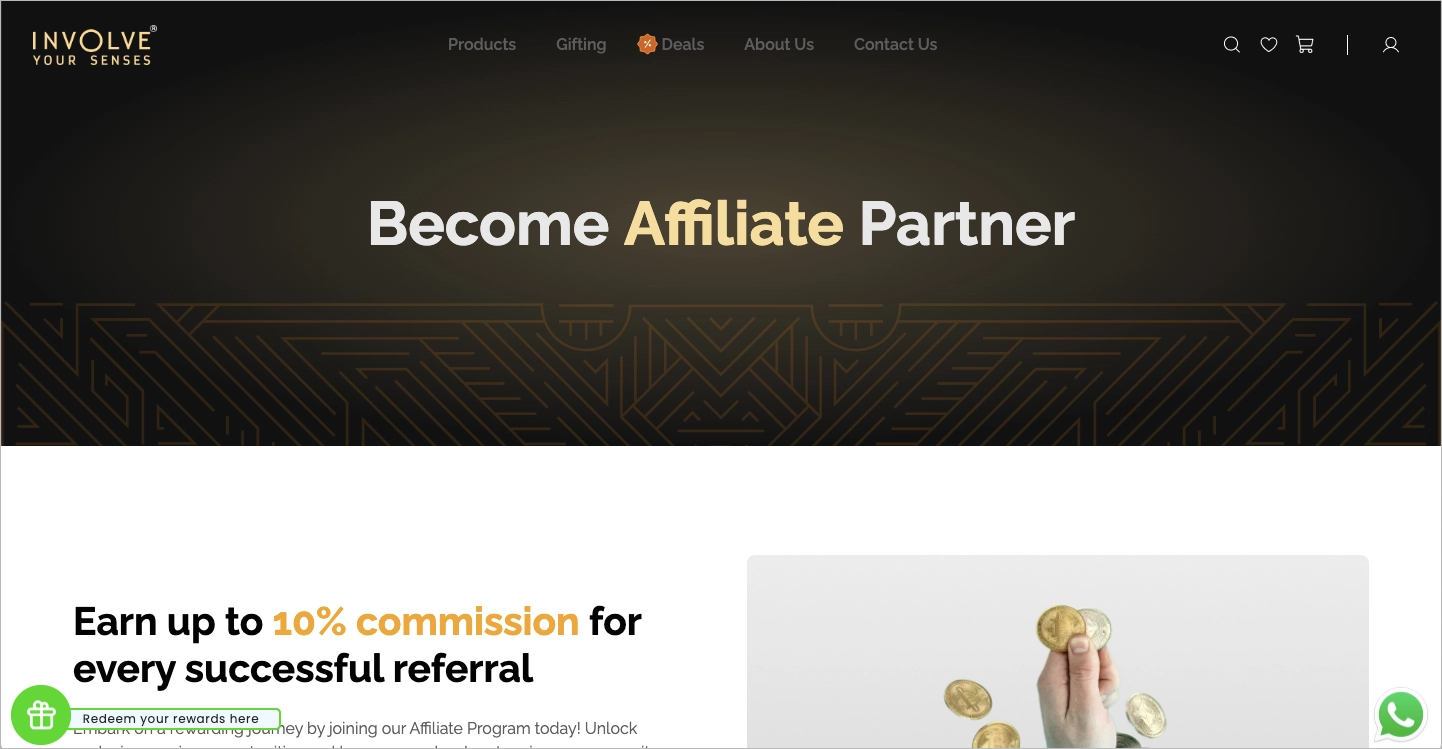
The use of high-quality images and a consistent color scheme helps in maintaining visual appeal and aligns with the brand’s identity. Furthermore, the page is optimized for mobile devices, ensuring a seamless user experience across different platforms.
Key takeaways to learn from this example:
- Clear headline: A simple slogan effectively communicates the value proposition.
- Strategic use of images and colors: It enhances visual appeal and aligns with the brand.
- Call-to-action buttons: Clear CTAs help to encourage sign-ups.
Improvement areas:
- CTA in the hero section: The lack of a CTA button in the first section decreases the chances for conversion.
- Trust-building elements: Social proof and testimonials would add credibility and encourage visitors to take action.
13. iCard
The affiliate landing page for iCard is designed to recruit partners to promote iCard’s financial products. It opens with a compelling header, “Become iCard’s affiliate partner – it’s worth it!” and invites visitors to register and establish a new income source. The design includes a prominent call-to-action button, a brief description of the program’s benefits, and appealing visuals that convey professionalism and trust.
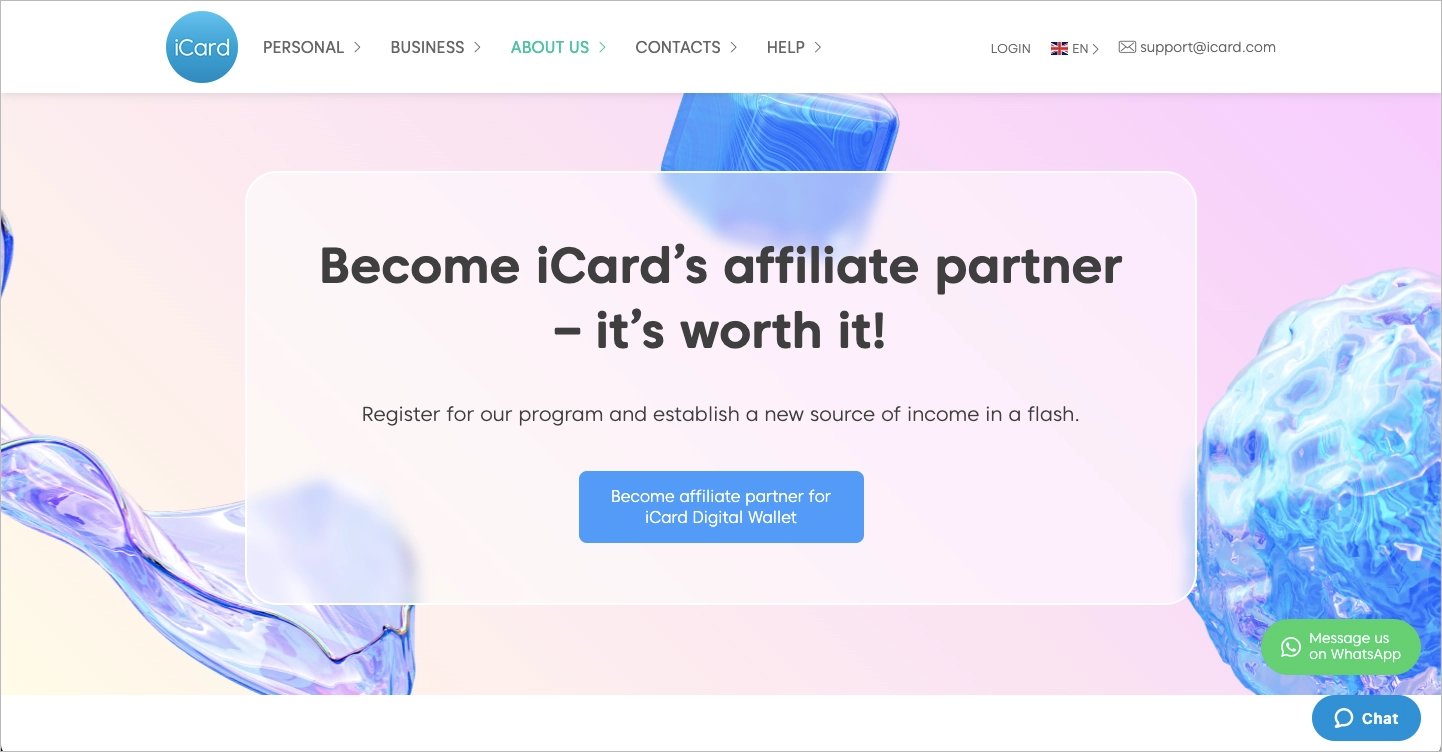
The layout is clean and structured, guiding the visitor through the process of becoming an affiliate. The “How it works” section breaks down the steps into three clear actions: Register, Refer iCard, and Earn money. This step-by-step explanation, combined with supporting images, simplifies the process and makes it more approachable. Additionally, the page highlights the support provided to affiliates, which can attract more partners.
Key takeaways to learn from this example:
- Clear, persuasive headline: The hero section immediately draws interest and communicates the value proposition.
- Step-by-step process: It simplifies the onboarding process, making it easy for visitors to understand how to get started.
- Strong call-to-action: Prominent buttons encourage immediate action.
- Visual appeal: Professional and attractive design elements enhance credibility.
- FAQ section: The answers to frequently asked questions can help to resolve doubts.
Improvement areas:
- Lack of testimonials: Social proof can help persuade those who are not yet convinced.
- Mobile optimization: Ensuring the page is fully optimized for mobile users can increase engagement and conversions from mobile traffic.
14. DesignNBuy
The affiliate landing page for the DesignNBuy Affiliate Program is designed to attract potential affiliates and persuade them to join the program. It features a clean layout and strongly emphasizes the benefits of becoming an affiliate partner. The page utilizes concise language to communicate the opportunity to earn a 10% commission on sales, along with other exclusive benefits.
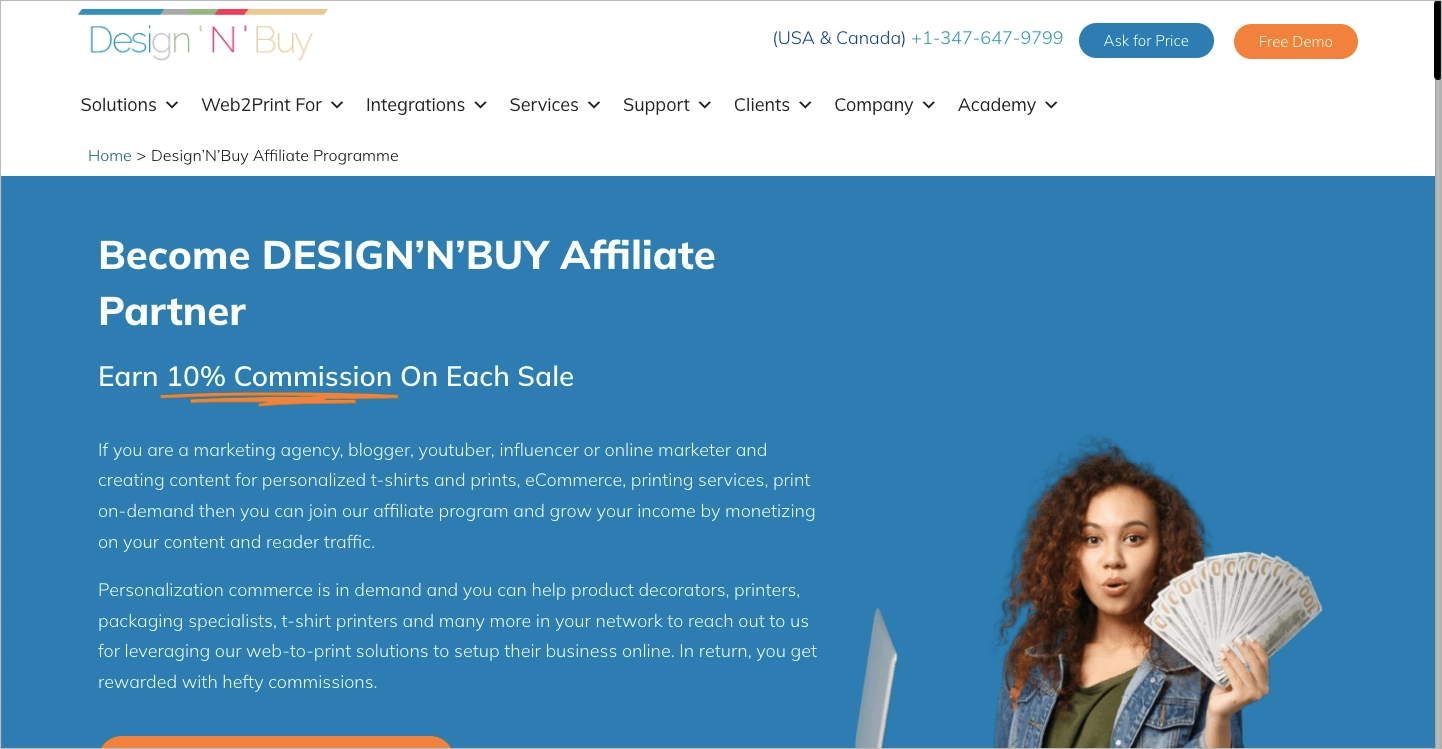
The layout includes visually appealing elements such as high-quality images, strategic use of color, and well-organized content sections. The call-to-action (CTA) buttons are prominently displayed, encouraging visitors to sign up for the affiliate program.
Key takeaways to learn from this example:
- Clear value proposition: The page clearly communicates the benefits of joining the affiliate program, including the commission rate and additional perks.
- Visuals: High-quality images and a professional design make the page visually appealing and help maintain visitors’ interest.
- CTAs: CTA buttons guide visitors towards taking action and signing up for the program.
Improvement areas:
- Too much text: There is an excessive amount of text in the initial section. Furthermore, other sections could also be shortened.
- Lack of social proof: Trust-building elements like testimonials, FAQs, and details about the program’s structure would address potential affiliates’ questions and concerns.
15. MACMAN Pro
The affiliate landing page of MACMAN Pro Ltd. effectively invites visitors to join their affiliate program, offering a compelling opportunity to earn passive income through a 5% commission and customer discounts. The page emphasizes the ease of tracking and the support provided, making it attractive for potential affiliates. The layout is clean and professional, reflecting the technical and modern nature of the company’s offerings.
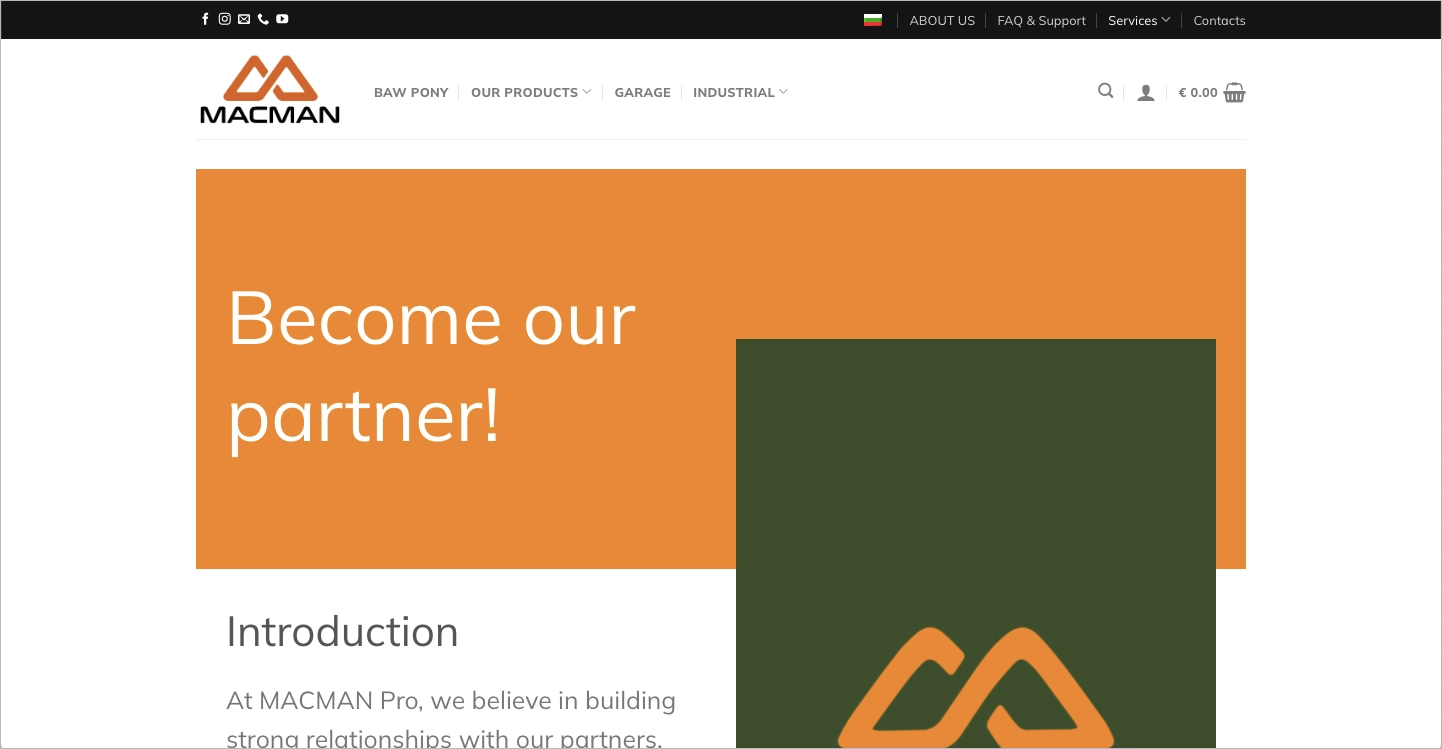
The page uses a cohesive color scheme and professional design elements that align with the company’s branding. It also integrates social proof by including links to MACMAN Pro Ltd.’s social media profiles, helping to build trust and credibility. Key takeaways from this example include the clear and persuasive messaging about the benefits of the affiliate program, the use of a professional and modern design, and the inclusion of step-by-step instructions to become a partner.
Key takeaways to learn from this example:
- Copy: Clear and persuasive messaging explains affiliate program benefits.
- Professional layout: Modern design aligns with company branding.
Improvement areas:
- CTA buttons: There are few call-to-action buttons on this landing page, with only two placed at the very bottom. Additionally, one of them is not even related to the landing page offer.
- Form fields: The form contains a large number of fields, which may overwhelm visitors.
- Benefits section: Listing benefits one after the other creates an uninviting block of text.
16. Discover Cars
The affiliate landing page for the Discover Cars Car Rental Affiliate Program effectively presents a clear, structured, and professional approach to attracting potential affiliates. The page highlights key benefits of the program, such as payouts of $20 per client, offering compelling reasons for affiliates to join. The landing page includes a prominent call-to-action (CTA) encouraging visitors to sign up, along with supporting content that explains the benefits and features of the program.
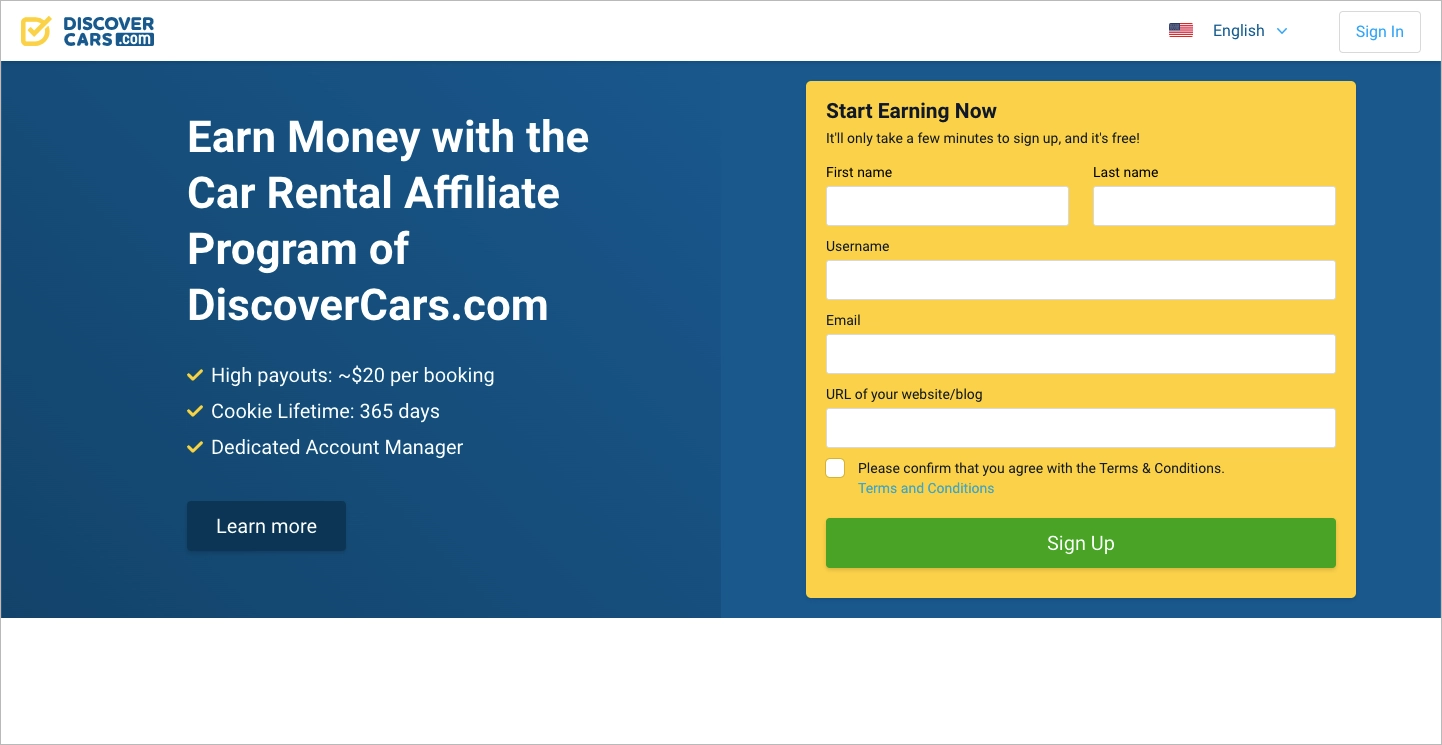
Key strengths of this landing page include its professional design and clear messaging. The page’s layout is clean and easy to navigate, ensuring that important information stands out. The use of bullet points and concise text helps in quickly communicating the benefits and key aspects of the affiliate program. Additionally, the inclusion of testimonials, awards, and trust badges can enhance credibility and encourage more sign-ups.
Key takeaways to learn from this example:
- Clear and concise presentation: The benefits and features of the affiliate program are highlighted effectively.
- Strong CTA: The sign-up button is prominent, making it easy for visitors to take action.
- Trust-building elements: There are many forms of social proof that can build credibility, including reviews, testimonials, suppliers’ logos, and awards.
Improvement areas:
- Updating the hero section: The current hero section seems outdated and could benefit from a more modern design to better capture visitors’ attention.
- Simplifying the form: The sign-up form could be streamlined to make it quicker and easier for potential affiliates to join, reducing friction in the conversion process.
5 Affiliate Landing Page Template Examples
Affiliate templates can simplify the process of creating landing pages. They offer pre-designed layouts that can be customized to fit the specific needs of an affiliate campaign. Platforms like Landingi provide a wide range of templates that can be tailored to create effective affiliate landing pages.
Look at 5 affiliate landing page template examples to get inspiration for your next campaign. These examples showcase various design principles and elements that can enhance the appeal of your page, making it more engaging for your target audience. Whether you’re focusing on a minimalistic approach or a more detailed presentation, you’ll find designs that can be easily adapted to suit your marketing goals.
1. Make Money Online template
Affiliate landing pages are created to highlight potential income. The Make Money Online template does the job perfectly by using inviting colors and clear visuals. It also leaves space for an attractive headline that will describe why your affiliate program is unique and worth joining. It’s simple yet powerful, directing visitors’ focus to your message.
Sections include:
- Benefits
- Description
- Social proof
- CTA
- How it works
- Countdown timer
Personalize this template’s colors, images, and text to unlock its full potential. Feel free to add or remove sections, tailoring them perfectly to your vision. This template can be used for free in all Landingi plans, including the Free plan and free trial.
2. Landing page template for product affiliation
The success of this product template lies in two key elements: a compelling heading and an eye-catching number. These components effectively achieve the objective of the affiliate landing page. Additionally, the clear call-to-action (CTA) button provides everything necessary for building an effective page for affiliate marketing.
Sections include:
- Statistics
- Description
- Bullet points
- CTA
- Parallax effect
- Video
- Testimonials
Adjust the template’s CTA and copy to promote your affiliate program, include your images and videos, and integrate the landing page into your marketing efforts. This template is available at no cost across all Landingi packages, which includes both the Free plan and the trial period at no charge.
3. Digital marketing services affiliate template
The Digital Marketing template is an excellent choice for your next affiliate landing page. It provides ample space to highlight your value proposition and explain why your offer and program can be valuable for potential partners. The call-to-action buttons are clear and direct visitors to a simple form.
Sections include:
- CTA
- Offer’s benefits
- Services descriptions
- Video
- “About us”
- Social proof
- Form
Incorporate your visuals and messaging into this template, focusing on how prospects can benefit from your offer. Adjust the CTA copy to be clear and direct. You can use this template for free in all Landingi plans, including the Free plan and free trial.
4. Landing page template for registering to an affiliate program
The use of interactive elements is highly effective in capturing visitors’ attention. This landing page template demonstrates this concept by incorporating a full-width background video in the hero section. Subsequent sections further reinforce the message by highlighting the benefits of the offer.
Sections include:
- Video background
- Form
- “About us”
- List of benefits
- Descriptions
- Statistics
- Gallery
- Map
- Social proof
- CTA
Use this template to create a compelling affiliate page that thoroughly describes your program and offers. Develop engaging copy and build a modern landing page to effectively drive affiliate program registrations. This template is free to use with all Landingi plans, including the Free plan and free trial.
5. Affiliate template for scheduling a meeting
If you want visitors to schedule a meeting with you to discuss your affiliate program, using a clear “Let’s talk” as a starting point can be most effective. This Agency template is designed for this purpose. It includes a prominent hero section and a simple call-to-action that smoothly directs users to a contact form, where they can leave their details if they are interested in joining your affiliate program.
Sections include:
- Clear hero shot
- “About us”
- Description
- Portfolio
- Benefits
- Contact form
Create a short and compelling headline and outline the most enticing advantages of your affiliate program. Personalize this template to construct a landing page that will attract numerous potential partners. You can use this template in all Landingi plans, which includes the Free plan and the free trial, at no cost.
What is The Best Affiliate Landing Page Builder?
The best affiliate landing page builder is Landingi, with its drag-and-drop advanced editor and optimization solutions to help users modify their landing pages for maximum conversions. This includes A/B testing capabilities, which allow marketers to compare different page versions to identify the most effective elements, and EventTracker for gathering data on user interactions. Landingi features an intuitive form builder that enables users to create custom forms essential for capturing leads and engaging with potential customers.
Moreover, Landingi boasts over 170 integrations with leading MarTech apps, facilitating seamless connections with other marketing tools. This ensures that landing pages can effortlessly become a part of a broader marketing strategy. The platform also offers a wide selection of fully customizable templates tailored to various industries, enabling rapid creation of landing pages that appeal directly to target audiences.
Choosing the best affiliate landing page builder depends on your specific needs, technical skills, and budget. Some top contenders in the market include the following:
- Landingi: Specifically tailored for affiliate marketers with a focus on ease of use and affordability. Offers A/B testing tool, built-in EventTracker, Smart Sections, AI Assistant, and over 400 templates.
- Leadpages: This platform is praised for its user-friendly interface and wide range of templates optimized for conversions.
- Unbounce: Offers advanced features like dynamic text replacement and AI-powered optimization tools.
- Instapage: Provides a collaborative platform with team-friendly features and advanced analytics.
- ClickFunnels: Known for its comprehensive sales funnel approach, ClickFunnels offers a robust set of features for creating high-converting landing pages.
When choosing a landing page builder, consider factors such as:
- Ease of use
- Template quality and variety
- A/B testing capabilities
- Integration with other marketing tools
- Price and scalability
- Customer support and resources
It’s often beneficial to take advantage of free trials offered by these platforms to test their features and determine which one best suits your needs.
How Can I Optimize My Affiliate Landing Page for Higher Conversion Rates?
To optimize your affiliate landing page for higher conversion rates, it’s important to adopt a multifaceted approach. Start with a clear and compelling headline that grabs attention and communicates your unique value proposition effectively. For example, “Boost Your Productivity by 50% with Our Time Management App” is more compelling than simply stating “Time Management App Available Now.” Your copy should be persuasive, utilizing the AIDA formula (Attention, Interest, Desire, Action) to address the visitor’s pain points and demonstrate how your offer provides a solution. For instance, highlighting how your app can help users prioritize tasks and achieve more in less time can be very effective.
A strong call-to-action (CTA) is also essential. Make your CTA buttons visually stand out and use action-oriented text like “Start For Free Now” or “Get Instant Access” rather than a generic “Submit.” Incorporating social proof through specific, detailed testimonials from satisfied customers can further bolster your page’s appeal. For example, a testimonial like “Thanks to this app, I’ve increased my daily output by 40% and finally have time for my hobbies!” can be quite convincing.
This means your page should look great and function well across various devices, screen sizes, and browsers. Fast loading speed is another important factor; aim to have your page load in under 3 seconds by compressing images, minifying CSS and JavaScript, and using content delivery networks (CDNs) to improve speed.
The importance of A/B testing cannot be overstated. Continuously test different elements of your page, including headlines, images, CTA button colors, and page layouts, to see what works best. Many landing page builders provide built-in A/B testing tools. Solutions like EventTracker or VWO can be very helpful for setting up and analyzing these tests.
Moreover, use high-quality visuals, such as professional images or videos, to showcase your product or demonstrate its benefits. Infographics can also be effective for presenting complex information in an easily digestible format. To build trust with your visitors, implement trust signals like security badges, money-back guarantees, or industry certifications. Lastly, creating a sense of urgency can encourage immediate action, whether through countdown timers for limited-time offers or displaying the number of products left in stock.
What Are The Key Elements of an Effective Affiliate Landing Page?
An effective affiliate landing page includes the following key elements:
- Attention-grabbing headline
- Subheadline that elaborates on the main benefit
- High-quality images or videos of the product or service
- Clear and concise product description
- Bullet points highlighting key features and benefits
- Customer testimonials or reviews
- Trust badges or security seals
- Clear and prominent call-to-action buttons
- Limited-time offers or scarcity elements (when appropriate)
- FAQ section to address common concerns
- Exit-intent pop-up
Continue reading to discover more about these elements.
Attention-grabbing Headline
Craft a captivating headline using persuasive language to emphasize the primary benefit. For example: “Earn Big with Our Top-Rated Affiliate Program – Start Making Money Today!.” An effective headline should be clear, concise, and compelling, immediately communicating the main advantage of your offer.
Subheadline
Elaborate on the main benefit and introduce secondary advantages to reinforce the value proposition. For instance: “Maximize Your Earnings with Our Affiliate Program – Enjoy High Commission Rates and Exclusive Marketing Support.” This provides a deeper insight into the value of the product or service, enticing the visitor to read further.
High-quality Images or Videos
Use high-quality images or videos to showcase the product or service in action. A fitness app, for instance, could display before-and-after visuals or a demonstration of its features. Visual content should be professional and relevant, helping to build trust and illustrate the product’s effectiveness.
Clear and Concise Product Description
Present a concise description highlighting key features and benefits, preferably in sections or bullet points for easy consumption. Ensure the language is straightforward and free of jargon, making it easy for visitors to understand the value of the product quickly.
Bullet Points of Key Features and Benefits
Provide a clear outline of the program’s features and benefits, for example:
- High commission rates to maximize your earnings
- Comprehensive marketing materials and resources
- Real-time performance tracking and detailed analytics
- A dedicated support team to assist you at every step
Bullet points help break down information into easily digestible parts, making it more likely that visitors will read and retain the information.
Customer Testimonials or Reviews
Include 3-5 detailed testimonials from satisfied partners, accompanied by photos to enhance credibility. Testimonials provide social proof, which can significantly increase trust and persuade potential customers by showing real-life success stories.
Trust Badges or Security Seals
Incorporate trust badges, security seals, and logos of recognized payment processors or industry accolades to build trust and credibility. These elements assure visitors that their personal information is secure and that the product or service is reputable.
Clear and Prominent Call-to-Action Buttons
Position clear and attention-grabbing CTA buttons strategically throughout the page, using contrasting colors to draw immediate attention. Effective CTAs should have a compelling copy, such as “Sign Up Today” or “Become an Affiliate,” and be easy to find and click.
Limited-time Offers or Scarcity Elements
Introduce limited-time offers or scarcity elements like “Earn Double Commission for the First Month” or “Only 20 Spots Left in Our Elite Affiliate Program” to drive urgency and motivate conversions. Scarcity and urgency can significantly boost conversion rates by encouraging visitors to act quickly.
FAQ Section
Address common concerns or objections through an FAQ section, which not only assists visitors but can also enhance SEO by integrating relevant long-tail keywords. This section should cover typical questions about the affiliate program, commission rates, payment schedules, marketing tools, and other pertinent topics.
Exit-intent Pop-up
Utilize an exit-intent pop-up to capture the attention of leaving visitors and present them with a special offer or additional valuable information, thereby potentially retaining their interest and engagement. An exit-intent pop-up might include a higher commission rate, an exclusive guide to successful affiliate marketing, or another incentive to keep the visitor from leaving the page.
What Is An Affiliate Landing Page Builder?
An affiliate landing page builder is a tool that allows affiliates to create professional-looking, high-converting landing pages without requiring advanced technical skills. Such tools significantly reduce the time and technical know-how required to create effective landing pages, freeing up affiliates to concentrate more on marketing strategy and campaign optimization.
Affiliate landing page builders typically offer the following 7 features:
- Drag-and-drop editors: Add, remove, and rearrange page elements without coding.
- Pre-designed templates: Choose from a variety professionally designed templates optimized for different niches and campaign types.
- Integration capabilities: Connect with email marketing services, CRM systems, payment processors, and analytics tools.
- A/B testing features: Create and compare multiple versions of a page to optimize performance.
- Mobile responsiveness: Ensure that landing pages look great on all devices by automatically adjusting layout and design.
- Analytics and reporting: Gain detailed insights into page performance, visitor behavior, and conversion rates.
- Form builders: Build custom lead capture forms to gather visitor information.
Some popular affiliate landing page builders include Lanidngi, Leadpages, and Unbounce. However, the best choice for you will depend on your specific needs, budget, and technical expertise.
What Are The Affiliate Landing Page Best Practices?
When creating landing pages for affiliate programs, it’s essential to keep in mind a few best practices to ensure their effectiveness. Affiliate landing page best practices include: focusing on simplicity, using compelling visuals, highlighting benefits over features, creating a sense of urgency, incorporating multiple CTAs, and eliminating distractions.
Below, you will find 12 best practices and tips to increase the likelihood of converting visitors into customers and maximizing your affiliate marketing efforts.
- Keep it simple: Focus on a single offer or product. Remove any unnecessary elements that could distract from your main message.
- Use compelling visuals: Incorporate high-quality images, videos, or infographics that support your message and showcase your product’s benefits.
- Emphasize benefits over features: Instead of listing technical specifications, show how the program will enhance the affiliate’s success. For example, “Boost Your Earnings Instantly” rather than “Includes advanced commission tracking.”
- Use limited-time offers, countdown timers, or scarcity tactics to encourage immediate action. For instance, “Join Now – Limited Slots Available in Our Top-Tier Affiliate Program!”
- Optimize for search engines: Use relevant keywords in your page title, headers, and content. Create unique meta descriptions for each page.
- Ensure consistency: Match your landing page’s design and messaging with your promotional materials and ad copy to create a seamless user experience.
- Provide multiple CTAs: Place call-to-action buttons at various points on the page, especially after presenting key benefits or addressing potential objections.
- Remove distractions: Minimize external links and focus the visitor’s attention on the main offer. Consider removing navigation menus on dedicated landing pages.
- Use persuasive copywriting techniques: Employ storytelling to create an emotional connection, use problem-solution frameworks, and incorporate power words that trigger action.
- Continuously test and improve: Regularly analyze your page’s performance using tools like Google Analytics. Use heatmaps and user recordings to understand visitor behavior.
- Optimize page load speed: Compress images, minify code, and leverage browser caching to ensure your page loads quickly on all devices.
- Use directional cues: Incorporate visual elements like arrows or images of people looking towards your CTA to guide visitor attention.
What Is The Average Affiliate Landing Page Conversion Rate?
Conversion rates for affiliate landing pages can vary widely depending on factors such as the niche, product type, traffic source, and overall page quality. However, here are some general benchmarks:
- The average conversion rate across all industries is around 2.35%, according to Capturly.
- A good conversion rate for affiliate landing pages typically ranges from 2% to 5%, according to SeedProd.
- Exceptional landing pages may achieve conversion rates of 10%-15% or higher, according to SeedProd.
- According to Speed Commerce’s 2024 e-commerce benchmarks report, the average conversion rate for e-commerce websites hovers around 2.5% to 3%.
- 60% of business leaders say that affiliate marketing has been effective in turning leads into customers.
However, these figures can vary significantly based on six factors:
- Niche: Some niches naturally convert higher than others. For example, B2B services often have lower conversion rates but higher average order values compared to B2C products.
- Traffic quality: Targeted, pre-qualified traffic from content marketing or email lists tend to convert better than broad, untargeted traffic.
- Offer type: Free trials or low-cost introductory offers usually convert higher than high-ticket items.
- Device type: Desktop users often convert at higher rates than mobile users, though this gap is narrowing.
- Page quality and relevance: Well-designed pages that closely match user intent typically perform better.
- Brand recognition: Known brands often see higher conversion rates due to established trust.
To put these numbers in perspective:
- If your landing page receives 1,000 visitors and has a 3% conversion rate, you’d generate 30 conversions.
- Improving your conversion rate from 2% to 4% would double your results without increasing traffic.
Remember, while these benchmarks are useful, it’s most important to focus on continuously improving your own conversion rates rather than fixating on industry averages.
Build Landing Pages For Your Affiliate Business With Landingi
Creating effective affiliate landing pages is a crucial skill in today’s digital marketing landscape. By understanding the key elements and best practices and using the right tools, you can significantly improve your conversion rates and boost your affiliate income. Remember that optimization is an ongoing process – continually test, analyze, and refine your pages to stay competitive in affiliate marketing.
For your affiliate business, considering Landingi as your go-to landing page builder could be a strategic move. This platform’s exceptional set of features is highly valuable for affiliate marketers. Landingi enables you to easily create and test multiple versions of your landing pages with its A/B testing feature, helping you to maximize conversions. Smart Sections allow for modular and reusable components that simplify the page design process. Another innovative feature is the AI Assistant for content generation, making it easier than ever to produce compelling and effective landing page copy. Additionally, Landingi allows for integrations with popular email marketing tools, CRM systems, and analytics platforms.
With its affordable pricing plans, Landingi is suitable for both beginners and experienced affiliates. Moreover, to help you kickstart your affiliate marketing efforts, Landingi offers a free 14-day trial along with access to tutorials and customer support, guiding you every step of the way.

